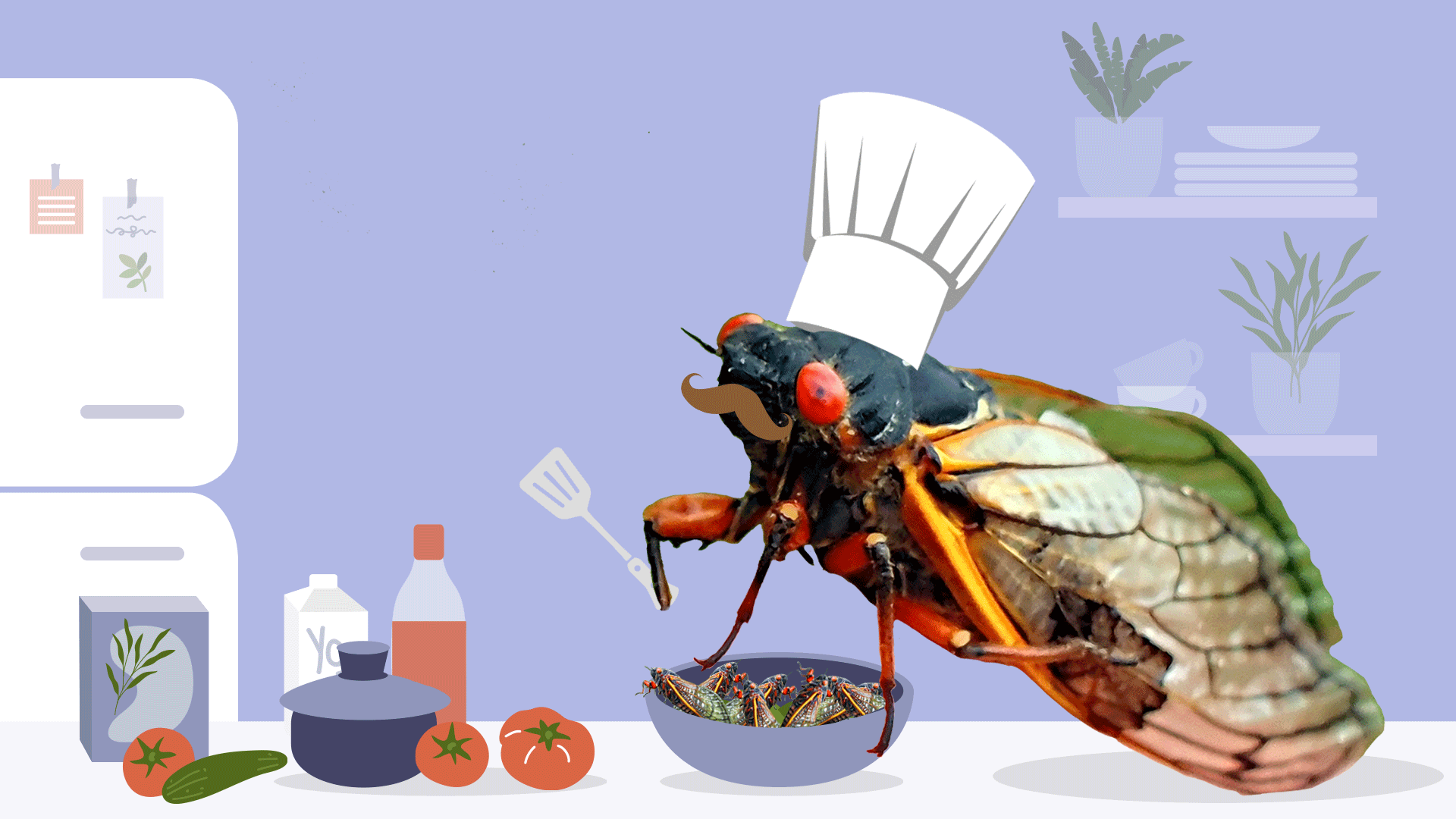- April 23, 2021
- By Annie Krakower
If the impending arrival of billions of Brood X cicadas has you wondering how to prepare (or how to avoid the outdoors), a UMD alum has a suggestion: Grab a frying pan.
During the last emergence of the crooning, climbing critters 17 years ago, Jenna Jadin Ph.D. ’08 created “Cicada-licious: Cooking and Enjoying Periodical Cicadas.” In addition to offering not-your-mama’s recipes for everything from stir fry to tacos to banana bread, the slightly tongue-in-cheek cookbook also helps make entomophagy, the practice of eating insects, something more readers might swallow.
“It was kind of a joke and was really just something to do to entertain myself while I was doing my research,” said Jadin, who spent hours every day as a Terp studying cricket mating behavior. “But it was also a way to sort of say, ‘Look, they’re so not scary … you can just walk outside and catch them and eat them if you want to, because Native Americans have been doing this in the past and people world over eat all kinds of insects every day.’”
Jadin, who now manages environmental and agriculture programs for development organizations such as the United Nations and international nongovernmental organizations, originally got the cookbook idea in a 2004 entomology class created for that year’s cicada emergence. Professor Emeritus and University of Maryland Extension Specialist Mike Raupp, known as “The Bug Guy,” taught it, encouraging his students, dubbed the “Cicadamaniacs,” to become cicada experts through literature reviews.
That led Jadin, a self-professed foodie, down what she calls an “internet wormhole,” reading about how Native Americans ate cicadas, how the insects were considered a delicacy in ancient Greece and Rome, and how Emperor Hirohito of Japan enjoyed insect dishes.
“In other parts of the world, bugs are definitely on the menu,” Raupp said. “Most Americans don't realize there is a global protein shortage because we’re blessed with more than we know what to do with, but in other parts of the world—if you go to parts of Asia, Africa or South America—it is a real concern.”
Acre for acre, insects provide more protein than a cow or sheep while requiring less space, less water and less food, said Jadin, who’s tried silkworm grubs, water beetles, crickets, grasshoppers and locusts. And there are countless ways to eat them, from fried to candied to ground into protein powder (Jadin’s go-to).
While a raw bite of cicada reminds Jadin of the taste of riding your bike through a swarm of bugs with your mouth open, they have a lightly nutty flavor when dried and baked. For adventurous eaters ready to try a recipe, she recommends using immature grubs, which can only be caught after dark on the night they are emerging; they can also be found climbing anything vertical. The next most tasty and nutritious are female adults, which can be captured anytime the cicadas are out. Females’ abdomens are full of eggs, and therefore protein and fat; males have hollow abdomens so they can amplify the sound they make—but because of this don’t have so much to eat.
In all cases, chefs should remove the legs and wings before preparing. And to be safe, Jadin said, avoid gathering them from areas where fertilizers and herbicides have been used.
The alum has started an updated version of “Cicada-licious”—which hopefully will be ready for the next 17-year emergence, she joked—that delves deeper into the history and benefits of entomophagy. In the meantime, this sampling from the 2004 edition should hold you over with a not-for-the-faint-of-heart three-course feast—if you can catch enough of your insect ingredients:
Shanghai Cicadas
Ingredients:
- 30 cicada grubs
- 2 Tbsp anise seeds
- 1 tsp salt
- 2 cups rice wine
- additional water and rice wine
- 8 cloves garlic, mashed
- Celery and turnip greens to garnish
- Oil for deep-frying
Directions:
- Boil the cicadas and anise in salted rice wine for five minutes, then remove the cicadas.
- Sauté the mashed garlic, adding enough of equal parts water and rice wine to make a thick paste.
- Deep-fry the cicadas, then skewer them with bamboo picks. Arrange them on a plate with the turnip greens, celery and garlic paste to look like cicadas climbing out of a mud pie into green foliage.
Yield:
4 appetizer-size servings
Borrowed from: WVU Magazine, Summer 1999
Maryland Cicadas
Ingredients:
- 1/2 cup Old Bay Seasoning
- 2 Tbsp salt
- 4 quarts water
- 1 (12 fluid ounce) can beer (optional)
- 8 red potatoes, quartered
- 2 large sweet onions, cut in wedges
- 2 pounds lean smoked sausage, cut in 2-inch lengths
- 8 ears fresh corn, broken in half
- 4 pounds large cicadas
Directions:
- In an 8-quart pot, bring Old Bay, salt, water and beer to a boil. Add potatoes and onions; cook over high heat for 8 minutes.
- Add smoked sausage to potatoes and onions; continue to cook on high for 5 minutes. Add corn to pot; continue to boil for 7 minutes. Add cicadas, cook for 5 minutes.
- Drain cooking liquid. Pour contents of pot into several large bowls, shallow pails or mound on a paper-covered picnic table. Sprinkle with additional Old Bay if desired.
Yield:
8 servings
Chocolate Covered Cicadas
Ingredients:
- 8 one-ounce squares of good-quality semisweet chocolate
- 30 cicadas
Directions:
- Roast teneral cicadas—newly hatched grubs—for 15 minutes at 225F.
- Meanwhile, melt chocolate in a double boiler over low heat. Dip insects in chocolate, place on wax paper and refrigerate until hardened.
Yield:
30 cicadas
